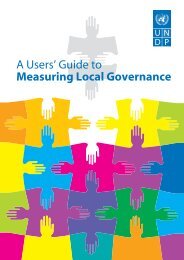planning a governance assessment - United Nations Development ...
planning a governance assessment - United Nations Development ...
planning a governance assessment - United Nations Development ...
Create successful ePaper yourself
Turn your PDF publications into a flip-book with our unique Google optimized e-Paper software.
One of the main strengths of this approach is the high level of disaggregation available. Direct policy implications are<br />
possible, for instance, when a particular single institution is identified as particularly prone to corruption. Because the<br />
modules are attached to surveys that provide rich socioeconomic information, all <strong>governance</strong> related phenomena can be<br />
disaggregated in relation to the incidence in poor/non-poor households, households with/without higher education, and<br />
households with a woman as household head, for example. This allows for a clearer picture of the vulnerability of different<br />
social classes.<br />
The DIAL 1-2-3 <strong>governance</strong> module adds about 13 minutes to a typical household survey conducted by an NSO/CSO.<br />
This additional time should not be too expensive. Obviously, costs will vary from country to country, based on the<br />
sample size of the survey, the coverage, size of the country, and infrastructure. Generally, the most expensive elements of a<br />
household survey are the sampling, making contact with the selected household and then with the selected<br />
respondent in that household. The marginal cost of adding about 100 <strong>governance</strong> questions to an existing household survey<br />
is quite reasonable in the DIAL 1-2-3 approach. In Peru, the DIAL <strong>governance</strong> module was added on to an existing survey of<br />
approximately 20,000 households for a cost of approximately US$60,000.<br />
(http://www.dial.prd.fr/)<br />
Example of cost, applying the DIAL <strong>governance</strong> module<br />
Information on total costs includes equipment, training, wages, services, data entry and consistency analysis for the DIAL<br />
<strong>governance</strong> module applied in Peru in 2004. The Peruvian sample size is relatively large with respect to other experiences<br />
in Africa or Madagascar where sample sizes usually are around 3000 households.<br />
• Planned sample: 20,000<br />
• Final sample size : 19,673<br />
• Unit cost: US$ 3.53<br />
• Total cost: US$ 52,990<br />
Source: DIAL<br />
Higher-cost options<br />
Democratic <strong>governance</strong> <strong>assessment</strong> in Mongolia. Beginning in 2003, the government of Mongolia with assistance from the<br />
UNDP embarked on a process of conducting a democratic <strong>governance</strong> <strong>assessment</strong> as part of strengthening democracy<br />
in the country. The <strong>assessment</strong> was a full-scale and comprehensive process that included consultations with civil society,<br />
country-contextualization of methodology, capacity development of local research institutions and political<br />
institutionalization of <strong>governance</strong> indicators. Approximately 130 indicators were developed, including a set of “satellite”<br />
indicators designed to capture the local context. The first round of results, Democratic Governance Indicators: Assessing the<br />
State of Governance in Mongolia, was published by the Government of Mongolia and UNDP in 2006.<br />
While more costly, many stakeholders agreed that the higher costs involved in undertaking such a comprehensive process<br />
were justified. The cost of the first round was quite high, but the second round was considerably less expensive. The current<br />
approach relies on the NSO conducting the household surveys with a reduced number of <strong>governance</strong> indicators (25), with<br />
costs falling into the medium range discussed above in the DIAL example. Today, democratic <strong>governance</strong> <strong>assessment</strong> forms<br />
part of the parliamentarian monitoring mechanisms of Mongolia’s MDG9 (Strengthen Human Rights and Foster Democratic<br />
Governance) and has had a real impact on democratization in Mongolia. The financial accounting below sets the standard<br />
for transparency and accountability concerning the use of funds.<br />
36<br />
Planning a Governance Assessment: A Guide to Approaches, Costs and Benefits








![GuÃa del Usuario ] - Governance Assessment Portal](https://img.yumpu.com/44740603/1/190x253/gua-a-del-usuario-governance-assessment-portal.jpg?quality=85)







